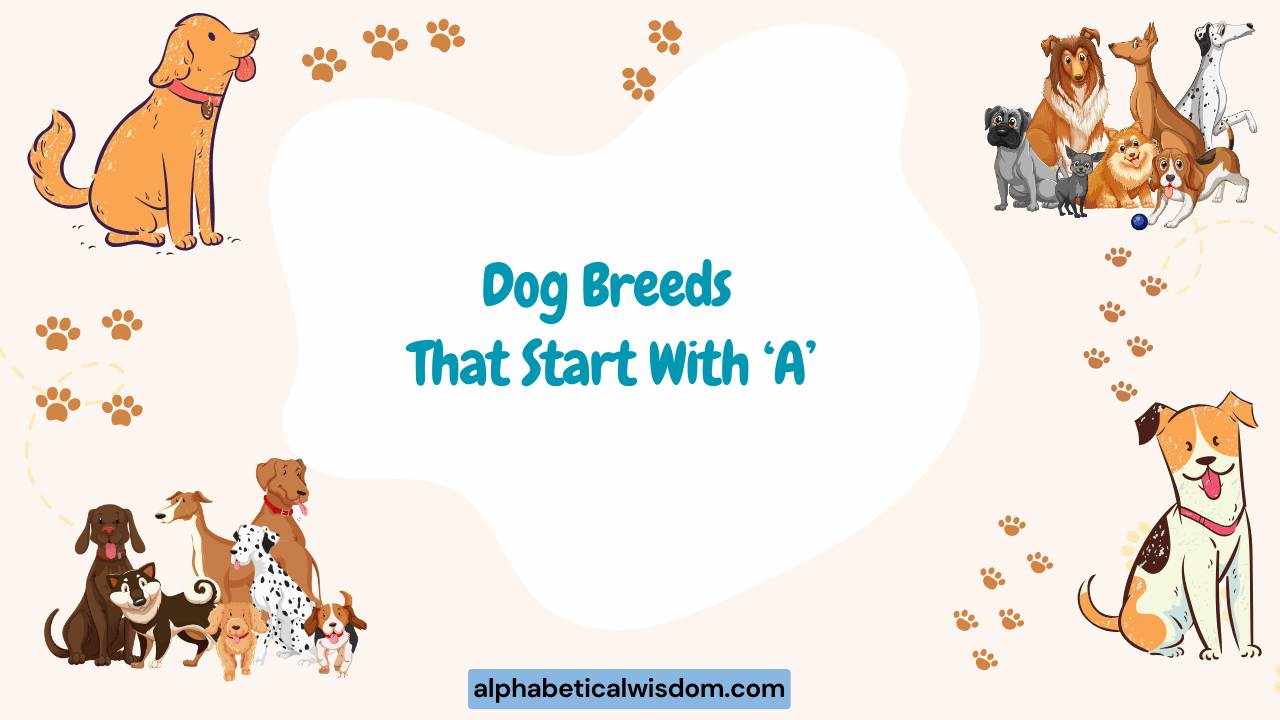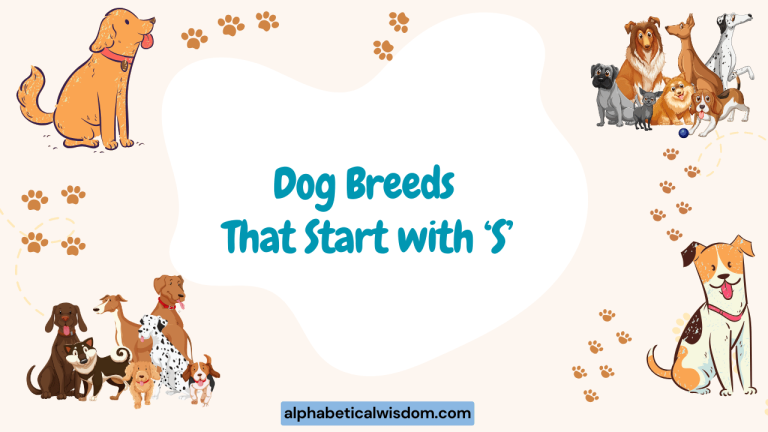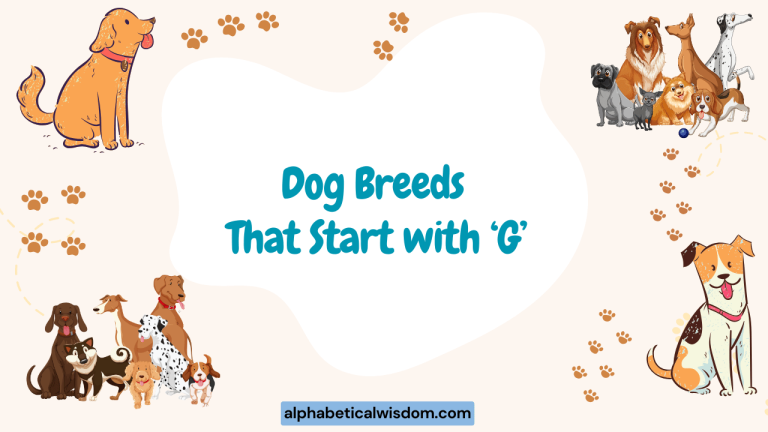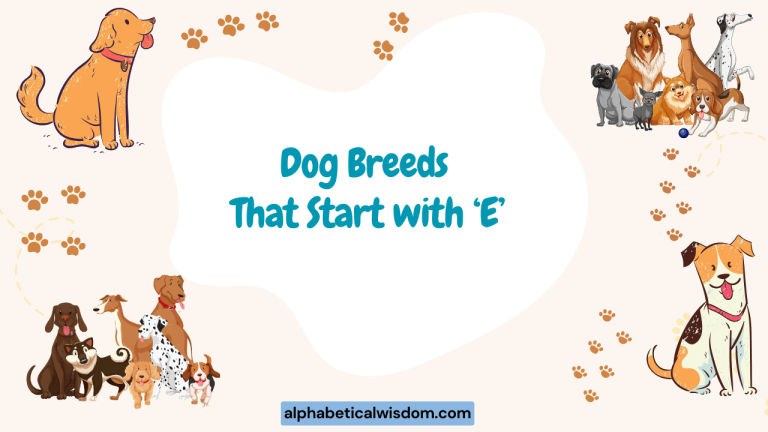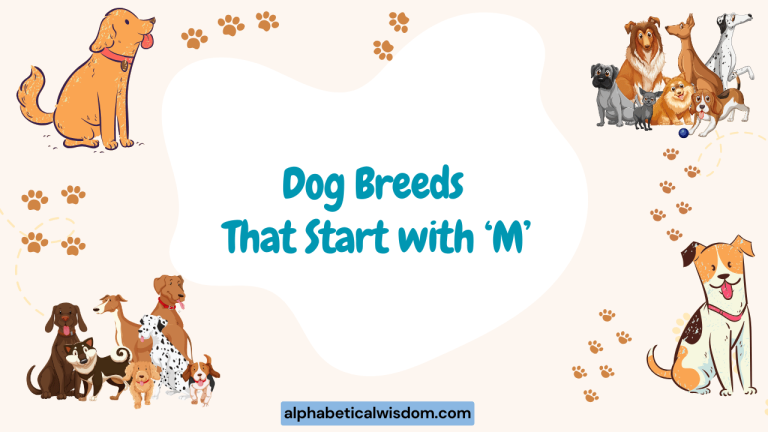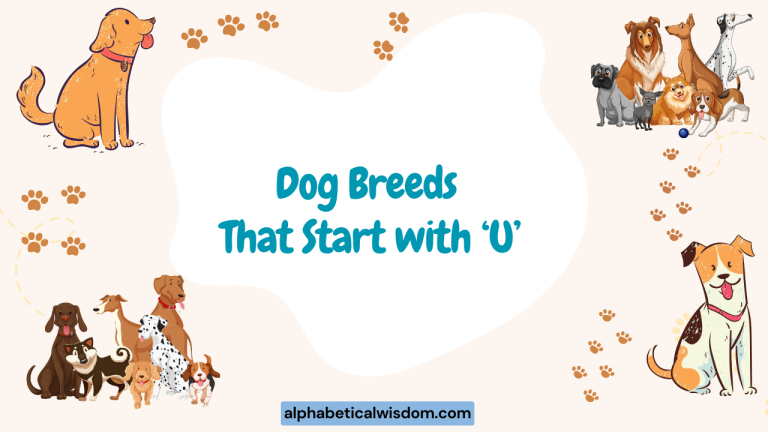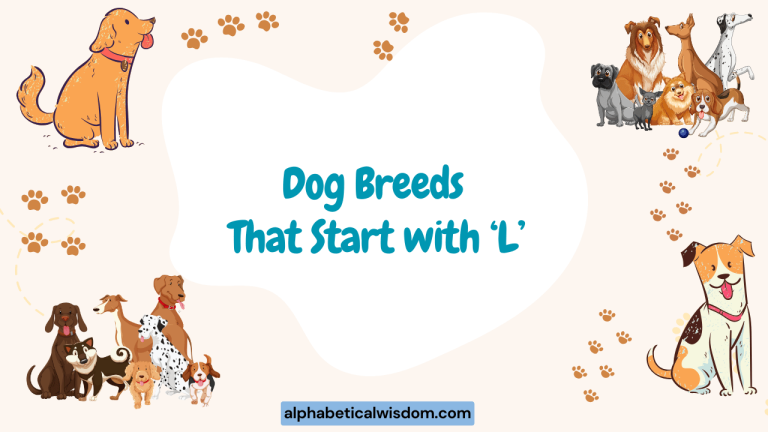Dog Breeds That Start With A: A Comprehensive Guide
Understanding dog breeds is more than just knowing their names; it involves recognizing their unique characteristics, origins, and purposes. Focusing on breeds that start with the letter “A” offers a manageable entry point into the broader world of canine diversity.
This article will guide you through various “A” breeds, exploring their historical backgrounds, physical traits, temperaments, and common uses. Whether you’re a dog enthusiast, a prospective owner, or simply curious, this guide provides valuable insights and practical knowledge to enhance your understanding of these remarkable animals.
Table of Contents
- Introduction
- Defining Dog Breeds
- Structural Breakdown: Breed Characteristics
- Types of Dog Breeds Starting with “A”
- Affenpinscher
- Afghan Hound
- Airedale Terrier
- Akbash Dog
- Akita
- Alaskan Malamute
- American Bulldog
- American Cocker Spaniel
- American Eskimo Dog
- American Foxhound
- American Hairless Terrier
- American Leopard Hound
- American Pit Bull Terrier
- American Staffordshire Terrier
- American Water Spaniel
- Anatolian Shepherd Dog
- Appenzeller Sennenhund
- Ariégeois
- Australian Cattle Dog
- Australian Kelpie
- Australian Shepherd
- Australian Stumpy Tail Cattle Dog
- Austrian Black and Tan Hound
- Examples of “A” Dog Breeds in Sentences
- Usage Rules: Describing Dog Breeds
- Common Mistakes When Discussing Dog Breeds
- Practice Exercises
- Advanced Topics: Canine Genetics and Breed Evolution
- Frequently Asked Questions
- Conclusion
Defining Dog Breeds
A dog breed is a specific and identifiable group of domestic dogs that are selectively bred to consistently reproduce specific traits, such as appearance, size, temperament, and behavior. Breeds are typically recognized by kennel clubs, which maintain breed standards that define the ideal characteristics of the breed. These standards serve as guidelines for breeders and judges in dog shows. The concept of a breed is rooted in the deliberate selection and mating of dogs with desired characteristics over many generations, resulting in a lineage that consistently produces offspring with those traits.
The classification of dog breeds varies among different kennel clubs and organizations. However, common classifications include working dogs, sporting dogs, herding dogs, toy dogs, terrier dogs, and non-sporting dogs.
Each classification reflects the historical or current purpose of the breed. For example, working dogs were bred to perform tasks such as guarding property or pulling sleds, while sporting dogs were bred to assist hunters in the field.
Understanding these classifications provides insight into the breed’s inherent behaviors and needs.
The function of a breed standard is to provide a blueprint for breeders and judges. It outlines the ideal physical and temperamental characteristics that define the breed.
This includes details about the dog’s size, coat type, color, head shape, body proportions, gait, and temperament. Breed standards are not static; they can evolve over time as breeders strive to improve the breed’s health, temperament, or conformation.
The context in which a breed is discussed often involves dog shows, breeding programs, or discussions about responsible pet ownership. In these contexts, the term “breed” carries significant weight, as it implies a certain level of predictability and consistency in the dog’s traits.
Structural Breakdown: Breed Characteristics
Describing a dog breed involves several key structural elements that provide a comprehensive understanding of its characteristics. These elements include the breed’s name, its origin, its physical attributes, its temperament, and its common uses.
Each element contributes to a complete picture of the breed and its role in the canine world.
The breed’s name is the most basic identifier, but it often provides clues about the breed’s origin or purpose. For example, the Alaskan Malamute’s name indicates its origin in Alaska and its connection to the Malamute Inuit people. The origin of a breed is crucial because it reveals the historical context in which the breed was developed. This context can explain the breed’s physical and temperamental traits. The physical attributes of a breed include its size, weight, coat type, color, head shape, body proportions, and gait. These attributes are often dictated by the breed standard and are important for identifying and classifying the breed.
The temperament of a breed refers to its characteristic behavior and personality traits. Some breeds are known for being friendly and outgoing, while others are more reserved or protective. Temperament is influenced by both genetics and environment, but breed standards typically outline the desired temperament for a particular breed. Common uses of a breed reflect its historical or current purpose. Some breeds were bred for hunting, herding, guarding, or companionship, while others are used for specialized tasks such as search and rescue or therapy work. Understanding the breed’s common uses provides insight into its inherent abilities and needs.
The patterns and rules for describing dog breeds are based on the breed standards maintained by kennel clubs. These standards provide a detailed description of the ideal characteristics of the breed, including physical attributes, temperament, and gait.
Breeders and judges use these standards to evaluate the quality of individual dogs and to ensure that the breed maintains its distinctive traits. The rules for describing dog breeds also involve using precise and descriptive language to convey the breed’s unique characteristics.
This includes using specific terms to describe coat colors, patterns, and textures, as well as using adjectives that accurately reflect the breed’s temperament and behavior.
Types of Dog Breeds Starting with “A”
The world of dog breeds is vast and diverse, with numerous breeds starting with the letter “A.” Each breed has its unique history, characteristics, and purpose. Here’s a look at some of the most well-known “A” breeds:
Affenpinscher
The Affenpinscher, also known as the “Monkey Terrier,” is a small, sturdy dog breed originating in Germany. Known for their distinctive wiry coat and expressive face, they were originally bred to hunt rodents in stables and kitchens.
Affenpinschers are intelligent, lively, and often described as having a mischievous personality.
Afghan Hound
The Afghan Hound is an ancient breed known for its striking appearance, characterized by its long, flowing coat and elegant demeanor. Originating in the mountains of Afghanistan, they were originally used for hunting both small and large game.
Afghan Hounds are independent, dignified, and require regular grooming to maintain their luxurious coat.
Airedale Terrier
The Airedale Terrier, often called the “King of Terriers,” is the largest of the terrier breeds. Originating in the Aire Valley of Yorkshire, England, they were bred to hunt otters and other small game.
Airedales are intelligent, confident, and versatile dogs, known for their courage and loyalty.
Akbash Dog
The Akbash Dog is a livestock guardian dog originating in Turkey. They are known for their large size, white coat, and gentle temperament.
Akbash Dogs are intelligent, independent, and highly protective of their flock or family.
Akita
The Akita is a powerful and dignified breed originating in Japan. They are known for their loyalty, courage, and independence.
Akitas were originally used for hunting bear and guarding royalty. They require experienced owners who can provide consistent training and socialization.
Alaskan Malamute
The Alaskan Malamute is a large and powerful sled dog originating in Alaska. They are known for their strength, endurance, and friendly disposition.
Malamutes were originally used to pull heavy loads over long distances in harsh conditions. They require plenty of exercise and a strong pack leader.
American Bulldog
The American Bulldog is a muscular and athletic breed originating in the United States. They are known for their courage, loyalty, and protective nature.
American Bulldogs were originally used for farm work and guarding property. They require experienced owners who can provide consistent training and socialization.
American Cocker Spaniel
The American Cocker Spaniel is a small and affectionate breed originating in the United States. They are known for their beautiful coat, gentle temperament, and playful nature.
Cocker Spaniels were originally used for hunting birds. They require regular grooming and plenty of attention.
American Eskimo Dog
The American Eskimo Dog is a small to medium-sized breed known for its striking white coat and friendly disposition. Despite its name, the breed originated in Germany, not Alaska.
American Eskimo Dogs are intelligent, playful, and eager to please, making them excellent companions.
American Foxhound
The American Foxhound is a scent hound originating in the United States. They are known for their speed, endurance, and hunting ability.
American Foxhounds were originally used for hunting foxes. They require plenty of exercise and a fenced-in yard.
American Hairless Terrier
The American Hairless Terrier is a unique breed known for its lack of coat. Originating in the United States, they are intelligent, playful, and energetic dogs.
American Hairless Terriers are also a great choice for people with allergies.
American Leopard Hound
The American Leopard Hound is a striking breed known for its distinctive spotted coat. Originating in the United States, they are versatile hunting dogs known for their tracking abilities and endurance.
American Leopard Hounds are energetic, intelligent, and require ample exercise.
American Pit Bull Terrier
The American Pit Bull Terrier is a muscular and powerful breed originating in the United States. They are known for their courage, loyalty, and intelligence.
American Pit Bull Terriers require experienced owners who can provide consistent training and socialization.
American Staffordshire Terrier
The American Staffordshire Terrier is a strong and muscular breed originating in the United States. They are known for their courage, loyalty, and intelligence.
American Staffordshire Terriers require experienced owners who can provide consistent training and socialization.
American Water Spaniel
The American Water Spaniel is a versatile hunting dog originating in the United States. They are known for their swimming ability, retrieving skills, and friendly disposition.
American Water Spaniels are energetic, intelligent, and require plenty of exercise.
Anatolian Shepherd Dog
The Anatolian Shepherd Dog is a large and powerful livestock guardian dog originating in Turkey. They are known for their independence, loyalty, and protective nature.
Anatolian Shepherd Dogs require experienced owners who can provide consistent training and socialization.
Appenzeller Sennenhund
The Appenzeller Sennenhund is a medium-sized herding dog originating in Switzerland. They are known for their energy, intelligence, and loyalty.
Appenzeller Sennenhunds require plenty of exercise and mental stimulation.
Ariégeois
The Ariégeois is a medium-sized scent hound originating in France. They are known for their hunting ability, endurance, and friendly disposition.
Ariégeois require plenty of exercise and a fenced-in yard.
Australian Cattle Dog
The Australian Cattle Dog, also known as a Blue Heeler or Queensland Heeler, is a medium-sized herding dog originating in Australia. They are known for their intelligence, energy, and loyalty.
Australian Cattle Dogs require plenty of exercise and mental stimulation.
Australian Kelpie
The Australian Kelpie is a medium-sized herding dog originating in Australia. They are known for their intelligence, energy, and work ethic.
Australian Kelpies require plenty of exercise and mental stimulation.
Australian Shepherd
The Australian Shepherd is a medium-sized herding dog originating in the United States, despite its name. They are known for their intelligence, energy, and loyalty.
Australian Shepherds require plenty of exercise and mental stimulation.
Australian Stumpy Tail Cattle Dog
The Australian Stumpy Tail Cattle Dog is a medium-sized herding dog originating in Australia. They are known for their intelligence, energy, and loyalty, as well as their naturally bobbed tail.
Australian Stumpy Tail Cattle Dogs require plenty of exercise and mental stimulation.
Austrian Black and Tan Hound
The Austrian Black and Tan Hound is a medium-sized scent hound originating in Austria. They are known for their hunting ability, endurance, and friendly disposition.
Austrian Black and Tan Hounds require plenty of exercise and a fenced-in yard.
Examples of “A” Dog Breeds in Sentences
This section provides examples of how to use the names of “A” dog breeds in sentences, demonstrating their proper usage and context. The sentences cover a range of scenarios, from describing physical characteristics to discussing breed-specific behaviors.
Below is a table showcasing examples of sentences using “A” dog breeds in various contexts:
| Breed | Example Sentence |
|---|---|
| Affenpinscher | The Affenpinscher’s mischievous expression always brings a smile to my face. |
| Afghan Hound | The Afghan Hound’s long, flowing coat requires extensive grooming. |
| Airedale Terrier | The Airedale Terrier is known for its intelligence and versatility. |
| Akbash Dog | The Akbash Dog stood guard over the sheep, protecting them from predators. |
| Akita | The Akita is a loyal and courageous breed, often used as a guard dog. |
| Alaskan Malamute | The Alaskan Malamute is well-suited for pulling sleds in cold climates. |
| American Bulldog | The American Bulldog’s muscular build makes it a powerful and athletic dog. |
| American Cocker Spaniel | The American Cocker Spaniel is a popular family pet due to its gentle nature. |
| American Eskimo Dog | The American Eskimo Dog’s white coat makes it stand out in the park. |
| American Foxhound | The American Foxhound is bred for its exceptional scent-tracking abilities. |
| American Hairless Terrier | The American Hairless Terrier is a good choice for people with allergies. |
| American Leopard Hound | The American Leopard Hound has a unique spotted coat that is quite striking. |
| American Pit Bull Terrier | The American Pit Bull Terrier needs early socialization and training. |
| American Staffordshire Terrier | The American Staffordshire Terrier is a strong and loyal companion. |
| American Water Spaniel | The American Water Spaniel loves to swim and retrieve objects from the water. |
| Anatolian Shepherd Dog | The Anatolian Shepherd Dog is a natural guardian of livestock. |
| Appenzeller Sennenhund | The Appenzeller Sennenhund is a herding dog from Switzerland. |
| Ariégeois | The Ariégeois is a French scent hound used for hunting. |
| Australian Cattle Dog | The Australian Cattle Dog is known for its high energy and intelligence. |
| Australian Kelpie | The Australian Kelpie excels at herding sheep in the outback. |
| Australian Shepherd | The Australian Shepherd is a popular breed for agility competitions. |
| Australian Stumpy Tail Cattle Dog | The Australian Stumpy Tail Cattle Dog is similar to the Australian Cattle Dog but has a naturally short tail. |
| Austrian Black and Tan Hound | The Austrian Black and Tan Hound is a skilled scent hound used for hunting in Austria. |
| Affenpinscher | My neighbor’s Affenpinscher is always barking at the mailman. |
| Afghan Hound | Many find the Afghan Hound to be one of the most beautiful dog breeds. |
| Airedale Terrier | The Airedale Terrier is a good choice for an active family. |
| Akbash Dog | Akbash Dogs require a lot of space to roam and patrol. |
| Akita | The Akita has a thick double coat that protects it from cold weather. |
The table above illustrates how to correctly use the names of “A” dog breeds in sentences, providing context and information about each breed. The sentences demonstrate a variety of uses, from describing physical characteristics to discussing breed-specific behaviors and needs.
Usage Rules: Describing Dog Breeds
When describing dog breeds, it’s important to follow certain usage rules to ensure clarity and accuracy. These rules involve using proper nouns correctly, employing descriptive adjectives effectively, and understanding the nuances of breed-specific terminology.
Proper Nouns: Dog breed names are proper nouns and should always be capitalized. This distinguishes them from common nouns and indicates that they refer to specific, recognized breeds. For example, “German Shepherd” is capitalized because it refers to a specific breed, while “shepherd dog” is not capitalized because it refers to a type of dog.
Descriptive Adjectives: Use descriptive adjectives to provide specific details about a breed’s physical characteristics, temperament, or behavior. Choose adjectives that accurately reflect the breed’s traits. For example, instead of saying “the dog is big,” you could say “the dog is a large and muscular American Bulldog.”
Breed-Specific Terminology: Familiarize yourself with breed-specific terminology to describe certain traits or characteristics accurately. For example, the term “ticking” refers to small, isolated patches of color on a white coat, often seen in breeds like the American Foxhound. Understanding these terms allows you to describe breeds more precisely.
Singular vs. Plural: When referring to a single dog of a specific breed, use the singular form of the breed name. When referring to multiple dogs of the same breed, use the plural form. For example, “I saw an Afghan Hound at the park” (singular) versus “There were several Afghan Hounds competing in the dog show” (plural).
Possessive Form: To show possession, use the possessive form of the breed name. For example, “The Affenpinscher’s coat is wiry” indicates that the coat belongs to the Affenpinscher.
Common Mistakes to Avoid: Avoid using vague or generic terms when describing dog breeds. Instead, use specific and descriptive language to convey the breed’s unique characteristics. Also, avoid making generalizations about entire breeds based on the behavior of individual dogs. Remember that each dog is an individual, and its behavior may be influenced by factors other than its breed.
Here is a table summarizing the usage rules for describing dog breeds:
| Rule | Example | Explanation |
|---|---|---|
| Capitalization | Correct: Alaskan Malamute Incorrect: alaskan malamute |
Breed names are proper nouns and should be capitalized. |
| Descriptive Adjectives | Correct: The energetic Australian Cattle Dog… Incorrect: The dog… |
Use specific adjectives to describe the breed’s traits. |
| Breed-Specific Terminology | Correct: The American Leopard Hound has a spotted coat. Incorrect: The dog has a patterned coat. |
Use breed-specific terms for accurate descriptions. |
| Singular vs. Plural | Correct: I saw an Akita. Correct: I saw two Akitas. |
Use the correct form depending on the number of dogs. |
| Possessive Form | Correct: The Airedale Terrier’s bark is loud. Incorrect: The Airedale Terrier bark is loud. |
Use the possessive form to show ownership or association. |
Following these usage rules will help you describe dog breeds accurately and effectively, ensuring that your descriptions are clear, informative, and respectful of the breed’s unique characteristics.
Common Mistakes When Discussing Dog Breeds
Discussing dog breeds can sometimes lead to common mistakes, especially when it comes to capitalization, using accurate terminology, and avoiding generalizations. Recognizing these mistakes and understanding how to correct them is crucial for clear and accurate communication.
Incorrect Capitalization: One of the most common mistakes is failing to capitalize the names of dog breeds. As proper nouns, breed names should always be capitalized.
- Incorrect: I saw an afghan hound at the park.
- Correct: I saw an Afghan Hound at the park.
Inaccurate Terminology: Using vague or generic terms instead of breed-specific terminology can lead to confusion.
- Incorrect: The dog has a patterned coat.
- Correct: The American Leopard Hound has a spotted coat.
Making Generalizations: Attributing specific behaviors or traits to an entire breed based on limited experience is a common mistake.
- Incorrect: All American Pit Bull Terriers are aggressive.
- Correct: American Pit Bull Terriers can be strong-willed and require experienced owners.
Misusing Singular and Plural Forms: Using the incorrect singular or plural form of a breed name can also be a mistake.
- Incorrect: I saw two Akita at the park.
- Correct: I saw two Akitas at the park.
Ignoring Breed Standards: Failing to consider breed standards when describing a dog can lead to inaccurate assessments of its characteristics.
- Incorrect: That Alaskan Malamute is too small.
- Correct: That dog, while resembling an Alaskan Malamute, is smaller than the breed standard allows.
The table below provides a summary of common mistakes and their corrections:
| Mistake | Incorrect Example | Correct Example |
|---|---|---|
| Incorrect Capitalization | I love my australian shepherd. | I love my Australian Shepherd. |
| Inaccurate Terminology | The dog has a long coat. | The Afghan Hound has a long, flowing coat. |
| Making Generalizations | All Akitas are aggressive. | Akitas require experienced owners and early socialization. |
| Misusing Singular/Plural | There was one Akbash Dog at the show. | There was one Akbash Dog at the show. |
| Ignoring Breed Standards | That Airedale Terrier is too short. | That dog, while resembling an Airedale Terrier, is shorter than the breed standard. |
By being aware of these common mistakes and actively working to avoid them, you can communicate more effectively and accurately about dog breeds, enhancing your understanding and appreciation of these diverse animals.
Practice Exercises
These practice exercises are designed to test your knowledge of “A” dog breeds and their characteristics. Each exercise focuses on different aspects of breed identification, terminology, and usage.
Complete the exercises to reinforce your understanding and improve your accuracy.
Exercise 1: Breed Identification
Identify the dog breed based on the description provided.
| Question | Answer |
|---|---|
| 1. This breed is known as the “Monkey Terrier.” | Affenpinscher |
| 2. This breed is famous for its long, flowing coat. | Afghan Hound |
| 3. This breed is the largest of the terrier breeds. | Airedale Terrier |
| 4. This breed is a livestock guardian dog from Turkey. | Akbash Dog |
| 5. This breed is known for its loyalty and courage in Japan. | Akita |
| 6. This breed is a powerful sled dog from Alaska. | Alaskan Malamute |
| 7. This breed is muscular and athletic, originating in the United States. | American Bulldog |
| 8. This breed is a small and affectionate spaniel. | American Cocker Spaniel |
| 9. This breed has a striking white coat and originated in Germany. | American Eskimo Dog |
| 10. This breed is a scent hound known for its speed and endurance. | American Foxhound |
Exercise 2: True or False
Determine whether the following statements are true or false.
| Statement | Answer |
|---|---|
| 1. The Affenpinscher originated in Afghanistan. | False |
| 2. The Afghan Hound requires minimal grooming. | False |
| 3. The Airedale Terrier is known as the “King of Terriers.” | True |
| 4. The Akbash Dog is a herding breed. | False |
| 5. The Akita is a small and delicate breed. | False |
| 6. Alaskan Malamutes are well-suited for hot climates. | False |
| 7. American Bulldogs were originally used for farm work. | True |
| 8. American Cocker Spaniels require little attention. | False |
| 9. American Eskimo Dogs originated in Alaska. | False |
| 10. American Foxhounds are known for their hunting abilities. | True |
Exercise 3: Fill in the Blanks
Complete the following sentences with the correct dog breed name.
| Question | Answer |
|---|---|
| 1. The ________ is known for its mischievous expression. | Affenpinscher |
| 2. The ________ requires extensive grooming to maintain its coat. | Afghan Hound |
| 3. The ________ is a versatile and intelligent terrier. | Airedale Terrier |
| 4. The ________ is a livestock guardian dog from Turkey. | Akbash Dog |
| 5. The ________ is a loyal and courageous breed from Japan. | Akita |
| 6. The ________ is a powerful sled dog from Alaska. | Alaskan Malamute |
| 7. The ________ is a muscular breed originally used for farm work. | American Bulldog |
| 8. The ________ is a gentle and affectionate family pet. | American Cocker Spaniel |
| 9. The ________ is known for its striking white coat. | American Eskimo Dog |
| 10. The ________ is a scent hound bred for fox hunting. | American Foxhound |
Advanced Topics: Canine Genetics and Breed Evolution
For advanced learners, exploring the topics of canine genetics and breed evolution provides a deeper understanding of how dog breeds have developed and diversified over time. This involves delving into the genetic basis of breed-specific traits, understanding the processes of artificial selection, and examining the historical factors that have influenced breed development.
Canine Genetics: The genetic makeup of dogs plays a crucial role in determining their physical and temperamental characteristics. Understanding the genes responsible for specific traits, such as coat color, size, and behavior, provides insight into the diversity observed across different breeds. Genetic studies have revealed that despite the vast differences in appearance and behavior, all dog breeds share a relatively recent common ancestry with the gray wolf. These studies have also identified specific genes that have been targeted by breeders to create breeds with desired traits.
Artificial Selection: The process of artificial selection, also known as selective breeding, has been instrumental in the development of modern dog breeds. Breeders intentionally select dogs with desirable traits and mate them together, with the goal of producing offspring that consistently exhibit those traits. Over many generations, this process can lead to significant changes in the physical and temperamental characteristics of a breed. Artificial selection has been used to create breeds for a wide range of purposes, including hunting, herding, guarding, and companionship.
Breed Evolution: The evolution of dog breeds is a complex process influenced by a variety of factors, including geography, climate, and human needs. Different breeds have evolved in different regions of the world, adapting to the local environment and fulfilling specific roles in human societies. For example, sled dog breeds like the Alaskan Malamute and Siberian Husky evolved in arctic regions to pull sleds over long distances, while herding breeds like the Australian Cattle Dog and Border Collie evolved to manage livestock in open pastures. Understanding the historical and environmental factors that have shaped breed evolution provides valuable insight into the unique characteristics of each breed.
Genetic Diversity: Maintaining genetic diversity within a breed is crucial for its long-term health and survival. When breeders focus too narrowly on selecting for specific traits, it can lead to a reduction in genetic diversity, making the breed more susceptible to genetic disorders and diseases. Responsible breeders strive to maintain genetic diversity by carefully selecting breeding pairs and avoiding inbreeding. Genetic testing can also be used to identify dogs that carry genes for genetic disorders, allowing breeders to make informed decisions about breeding.
By exploring these advanced topics in canine genetics and breed evolution, you can gain a deeper appreciation for the complexity and diversity of dog breeds, as well as the role that humans have played in shaping their development.
Frequently Asked Questions
This section addresses some frequently asked questions about dog breeds, providing clear and concise answers to common queries.
- What is the difference between a breed and a type of dog?
A breed is a specific and recognized group of dogs that consistently reproduce specific traits, while a type of dog refers to a broader category based on function or appearance. For example, a “terrier” is a type of dog, while an “Airedale Terrier” is a specific breed within that type.
- How are dog breeds classified?
Dog breeds are typically classified by kennel clubs and organizations based on their historical or current purpose, such as working dogs, sporting dogs, herding dogs, toy dogs, terrier dogs, and non-sporting dogs. Each classification reflects the breed’s inherent behaviors and needs.
- What is a breed standard?
A breed standard is a detailed description of the ideal characteristics of a breed, including physical attributes, temperament, and gait. It serves as a guideline for breeders and judges in dog shows.
- How do I choose the right dog breed for me?
Choosing the right dog breed depends on your lifestyle, living situation, and personal preferences. Consider factors such as the breed’s energy level, grooming needs, temperament, and compatibility with children and other pets. Research different breeds and talk to breeders or owners to learn more about their specific needs.
- Are mixed-breed dogs healthier than purebred dogs?
Mixed-breed dogs can sometimes be healthier than purebred dogs due to their greater genetic diversity, which reduces the risk of inheriting genetic disorders. However, both mixed-breed and purebred dogs can be prone to certain health problems, so it’s important to choose a dog from a reputable breeder or rescue organization that prioritizes health and welfare.
- How can I identify a dog breed if I don’t know its name?
You can try to identify a dog breed by observing its physical characteristics, such as size, coat type, color, and head shape. You can also use online resources, such as breed identification tools or dog breed guides, to compare the dog’s characteristics to those of different breeds. Consulting with a veterinarian or dog expert can also be helpful.
- What is the role of genetics in determining a dog’s breed characteristics?
Genetics play a crucial role in determining a dog’s breed characteristics, including physical traits, temperament, and behavior. Specific genes are responsible for different traits, and breeders selectively breed dogs with desired traits to pass those traits on to their offspring. However, environment and training also play a role in shaping a dog’s behavior and personality.
- How has artificial selection influenced the development of dog breeds?
Artificial selection, also known as selective breeding, has been instrumental in the development of modern dog breeds. Breeders intentionally select dogs with desirable traits and mate them together, with the goal of producing offspring that consistently exhibit those traits. Over many generations, this process can lead to significant changes in the physical and temperamental characteristics of a breed.
Conclusion
Exploring the world of dog breeds, particularly those starting with the letter “A,” offers a fascinating glimpse into the diversity and complexity of the canine world. Each breed has its unique history, characteristics, and purpose, shaped by both genetics and human influence.
By understanding the structural elements that define a breed, following the usage rules for describing them, and avoiding common mistakes, you can communicate more effectively and accurately about these remarkable animals.
Whether you are a dog enthusiast, a prospective owner, or simply curious, the knowledge and skills you have gained from this guide will enhance your appreciation for dog breeds and their role in our lives. Remember to continue learning and exploring the vast world of canine diversity, and always approach discussions about dog breeds with respect and accuracy.
